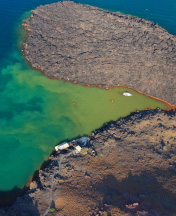According to research and excavations in Santorini, the first human presence on the island goes back to the Neolithic period. The discoveries made in a city buried near Akrotiri and the splendid Red Beach revealed the existence of an ancient Minoan colony, which is very much reminiscent of the cities found in Crete. In ancient times, the island of Santorini was known as Strongili. In 1500 B.C., Strongili suffered a huge volcanic explosion, which sunk the center of Santorini, while the many subsequent earthquakes destroyed a large segment of the remaining island. According to history, the Phoenicians settled in ancient Thera around 1300 B.C. and remained there for five generations. Afterwards, around 1100 B.C., the island was taken over by the Lacedaemonians. In the 7th and 6th centuries B.C., Thera traded with most islands and cities in Greece, while during the Hellenistic period, it became a major trading center and naval base, due to its perfect strategic location. The island was under Byzantine rule from 1200 to 1579 A.D., and in 1204 A.D., it was ceded to Marco I Sanudo of Venice and became part of the Duchy of the Aegean. Venetians named the island after Santa Irini, a Catholic church. Afterwards, during Turkish rule, Santorini achieved a growth in trade, but because of the wars, its economy went into decline, and residents abandoned the island after the devastating earthquake of 1956. The island's tourism development started during the '70s, and it is currently one of the most popular destinations around the world.












